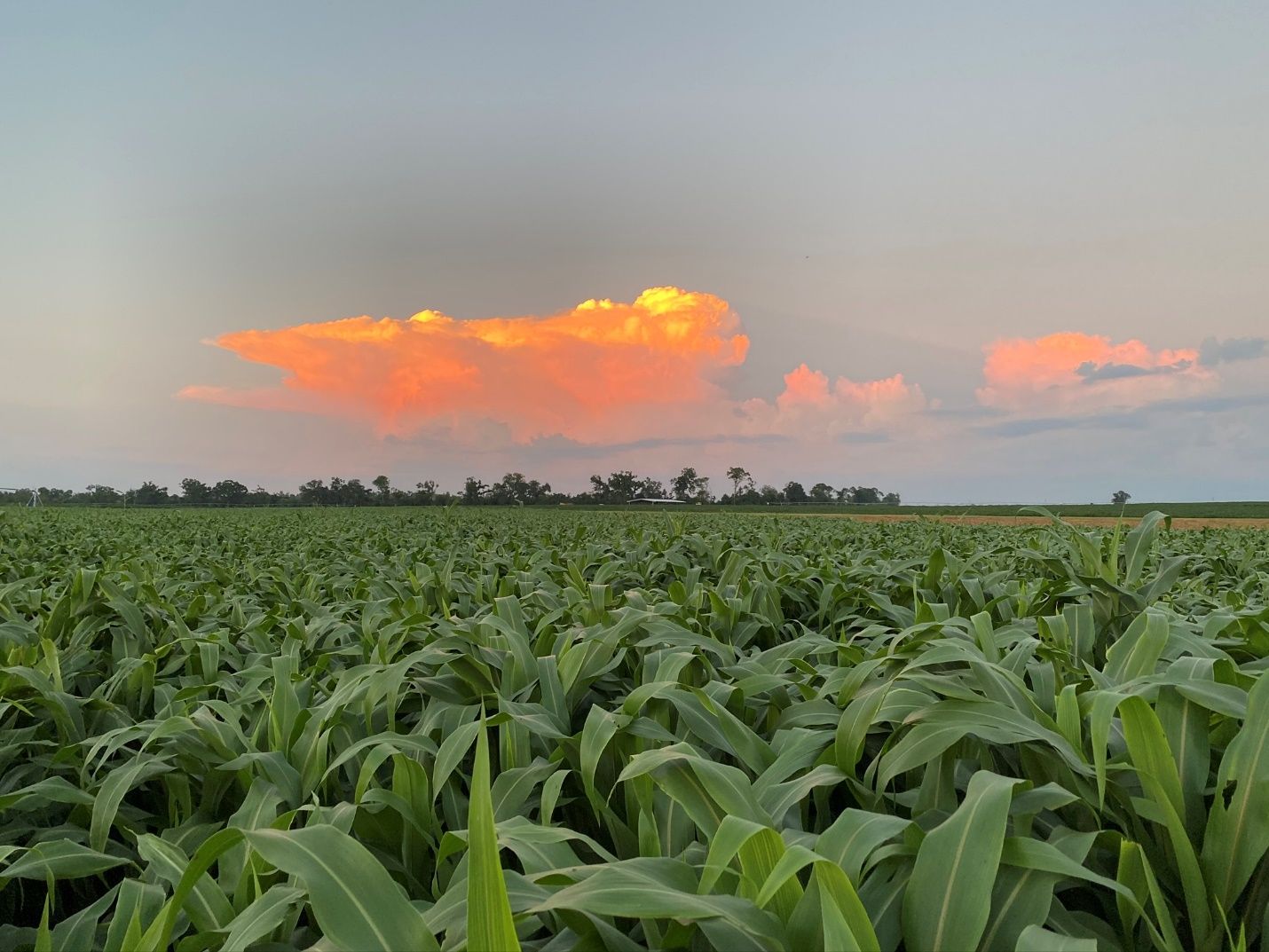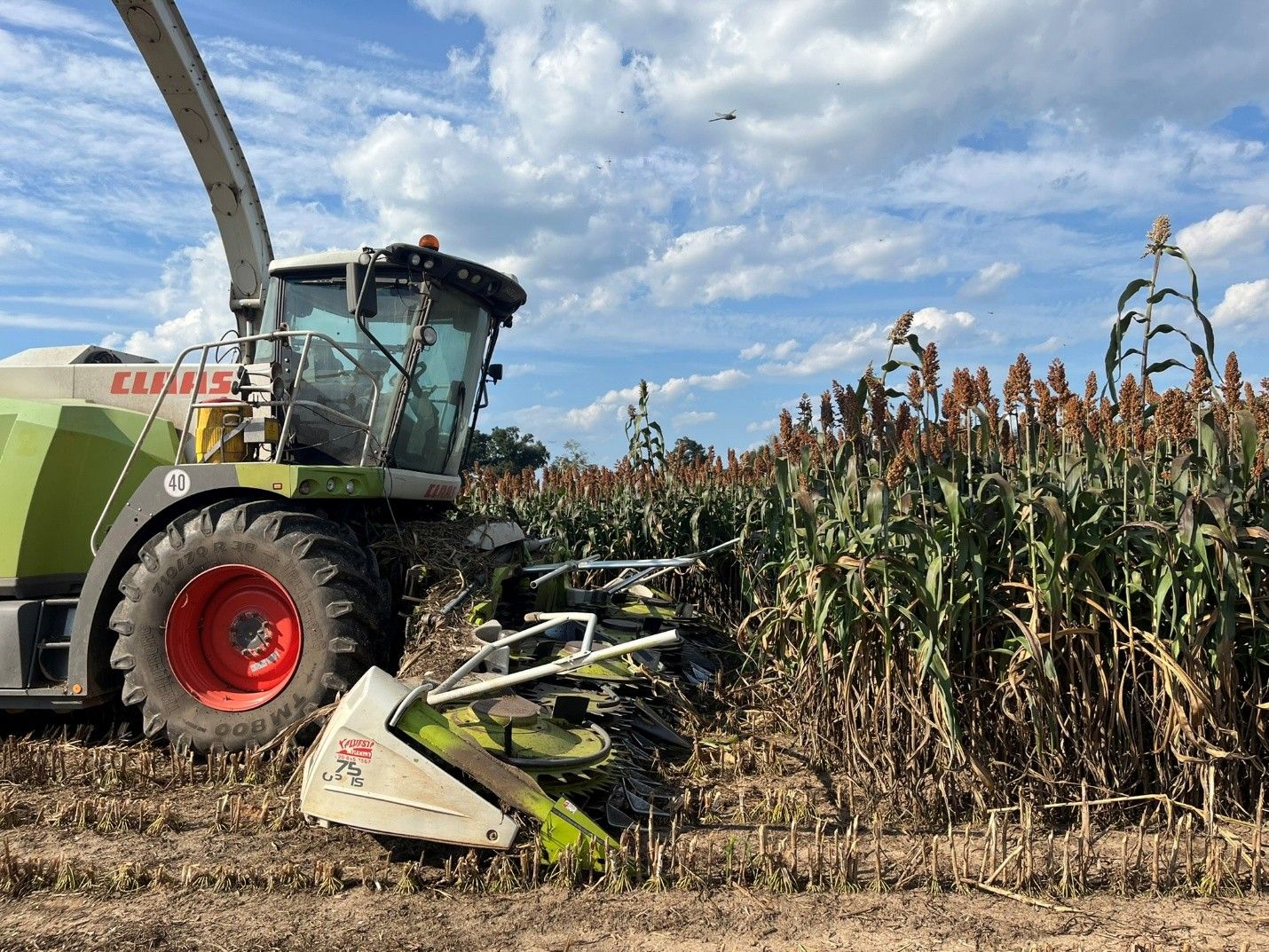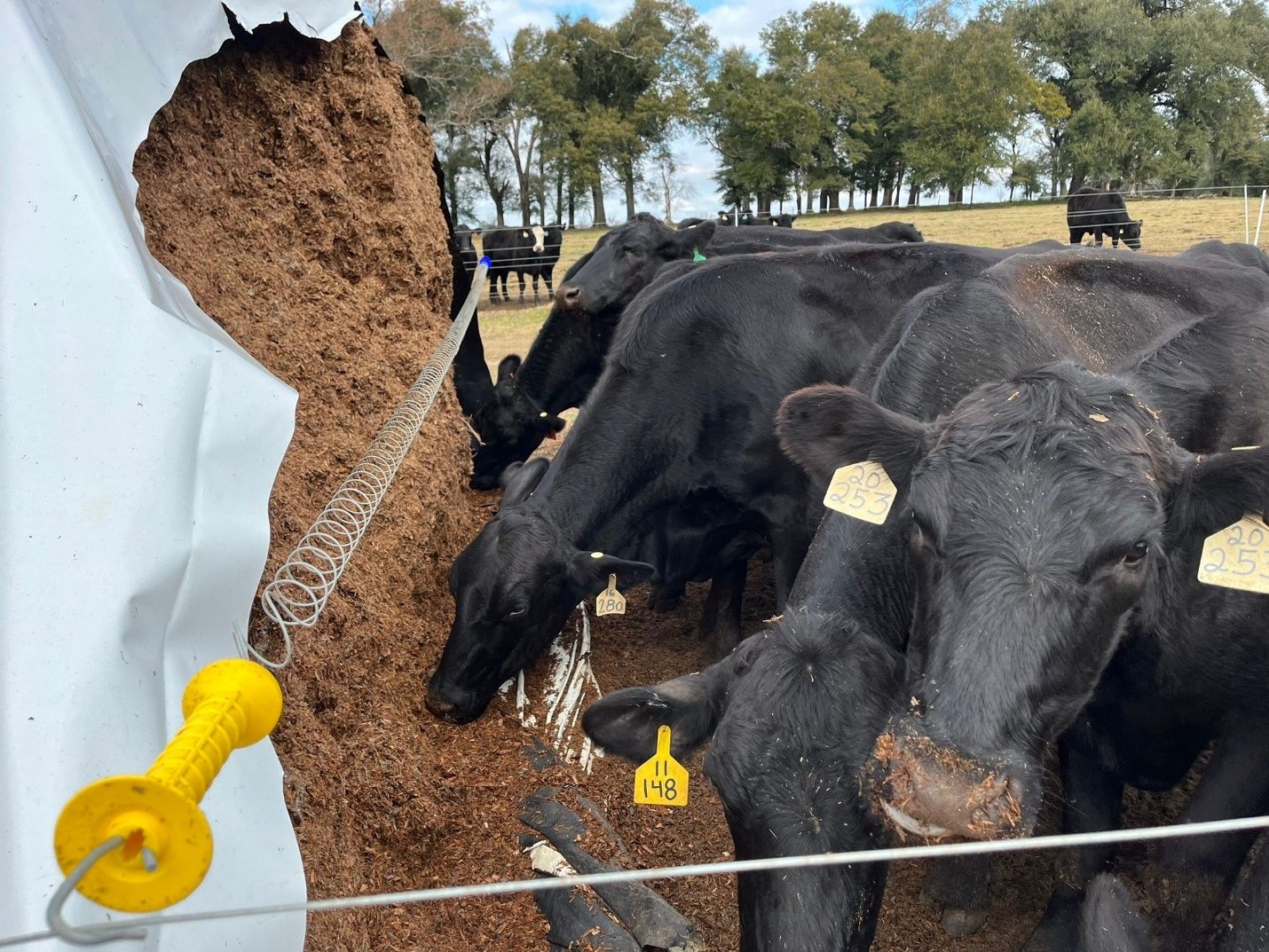Introduction
Cattle backgrounding refers to the period of growth cattle experience between weaning and finishing at the feedlot (in the case of fed cattle) or entering the herd for the breeding season (in the case of replacement heifers). Backgrounding calves has several benefits, among them:
- Calves can be grown at relatively low cost during this phase as compared to during the finishing phase.
- Calves’ diets during this phase contain a high forage content.
- Calves can receive a complete vaccination program to prepare them for shipping to feedlots.
- Backgrounding has remained profitable over several years and is well suited for medium-sized livestock operations.
Backgrounding systems in different regions present diverse opportunities and challenges depending upon each region’s seasonal patterns of cattle production, prices, and forage availability. Although Florida is mostly a cow-calf state, there is a potential opportunity to add value to weaned calves by backgrounding. Using silage-based diets, typically sorghum or corn silage with the inclusion of a protein concentrate, can be a good strategy for backgrounding cattle to be sold at heavier weights and during months of the year when demand is greater, and prices are therefore better (typically February to April).
Sorghum has been gaining attention in Florida as a crop alternative harvested as whole plant silage for inclusion in backgrounding diets as the main roughage source to fill the forage gap in winter-feeding programs. Sorghum (Figure 1) presents advantages over other summer annual forages, especially its drought tolerance and its reliability for dry matter production. Because it is drought-tolerant, sorghum can produce feed in conditions that cause other potential forage crops to fail. Information about types of sorghum can be found at https://edis.ifas.ufl.edu/publication/AG343. More information about silage is available at https://edis.ifas.ufl.edu/publication/AA269 and https://edis.ifas.ufl.edu/publication/AG180.

Credit: UF/IFAS NFREC
Sorghum harvested as whole-plant silage produces on average 14 tons of as-fed forage per acre (considering 35% dry matter), or 5 tons of silage dry matter (DM)/acre (2020 UF/IFAS variety trials) with irrigation provided as needed. These forage yields can be produced even without irrigation in years where rainfall is evenly distributed. In dry years or with uneven rainfall distribution, UF/IFAS sorghum variety trials have obtained yields between 2.5 and 5 dry tons/acre. Sorghum is both cost effective and remarkable from the standpoint of water use efficiency. Indeed, this crop provides good quality feed at a cost per ton of forage DM that is far below many other forage alternatives for the region. Furthermore, advances in sorghum genetics and innovations in crop technology such as selective insecticides to control challenging pests (e.g., sugarcane aphids) facilitate the production of sorghum in Florida and the rest of the southeastern United States. Information about the different hybrid evaluations UF/IFAS performed can be found at the UF/IFAS Hybrid Decision Tool.
The objective of this publication is to share the experience of three consecutive years at the UF/IFAS North Florida Research and Education Center (NFREC) in Marianna, Florida, using whole-plant sorghum (Sorghum bicolor) silage as the main dietary ingredient for growing heifers. This report is to be used by county Extension agents and cattle producers to reference a range of expected weight gains, feed conversion rates, and costs when using sorghum silage as the main dietary ingredient in backgrounding beef cattle diets.

Credit: UF/IFAS NFREC
Guidelines for a Successful Sorghum Silage-Based Diets Program
Planting
- Planting date: As seen in the UF/IFAS hybrid variety trials, planting early in the season (spring) results in greater yields as compared with crops planted later (summer). However, there is also a possibility for growing sorghum after corn in the same season (double cropping), thus increasing the amount of dry matter produced per acre.
- Scouting: Scouting is very important to diminish the incidence of whorl worms and sugar cane aphids. These two pests are a major concern in sorghum crops and can cause significant damage and yield losses. Early detection of these insects can help producers take effective action against them. Several options are available for insect control. These can be found in Table 1 below and in https://edis.ifas.ufl.edu/publication/AA269
- Fertilization: Fertilization should follow a soil analysis and recommendation. Split applications of nitrogen and potassium are recommended. The starter fertilization with nitrogen and phosphorus should occur at seeding, and a second fertilization should be delivered at the V6 stage, when the collar of the fifth leaf is visible, and the plant has reached a height of approximately 7 to 9 inches. At this growth stage, sorghum root systems are developing rapidly, which reduces the risk of fertilizer runoff and leaching of nutrients. The V6 stage is a time of rapid growth that increases the nutrient demand of the crop, hence the two-phased fertilization strategy. For more detail on sorghum fertilization visit: https://edis.ifas.ufl.edu/publication/AA130.
- Weed control: Weed control is crucial for this crop because no glyphosate-resistant varieties are yet available. Therefore, sorghum cannot be sprayed with glyphosate to control weeds; instead, use a good preemergent weed control program. For further herbicide strategies see: https://edis.ifas.ufl.edu/publication/WG002.
Harvesting
- Maturity: harvesting at the hard dough stage maximizes yield and energy content. It also reduces the amount of water harvested, transported, and ensiled, reducing total costs per ton of dry matter. However, if no processor is available, harvesting earlier is recommended (e.g., soft dough).
- Kernel processing: sorghum grains are comparatively small and hard to break, and their starch is located inside of the hard outer shell. We must try to crack that shell, called the pericarp, to release the starch and allow cattle to access and digest it. Our studies showed that kernel processing increases starch digestibility, reduces sorting by the animals, and improves feed conversion rates. Ask your contractor to set the kernel processor to a roll gap of 1 mm (0.04 inch) and a theoretical length of cut of no more than 15 mm (0.6 inch). If the harvester does not have a kernel processor, harvesting at a lower maturity stage (e.g., soft dough grain) and allowing the ensiled forage to ferment for a longer time can help increase the cattle’s utilization of starch. At this earlier stage, the protein matrix surrounding the starch in the kernel is weaker and will degrade with time, allowing the cows’ rumen microbes to access the starch granules.
- Inoculation: silages must be allowed ferment and produce the organic acids that drop the pH and thus preserve the feed and prevent it from spoiling. Using microbial inoculants enhances this fermentation and causes this beneficial pH drop to happen faster. Consider the use of inoculants as a safety measure when making your silage. Homo-fermentative inoculants are intended to reduce pH faster, while hetero-fermentative inoculants are intended to extend aerobic stability and reduce DM losses of the silage at feed out. Mixed combinations of homo and heterofermentative inoculants are also available.
Feeding
- Supplement protein: sorghum silage has a low concentration of crude protein (less than 9% typically), and therefore producers must include some type of protein supplementation. Without adequate protein, cattle will not thrive. In Florida, the most common byproducts available with high crude protein concentration are distillers’ grains, gluten feed, and cottonseed meal. In case you need help with nutrient balancing of your ration, contact your local UF/IFAS Extension office https://sfyl.ifas.ufl.edu/find-your-local-office/. Our studies showed that when no protein was added to silage-based diets, cattle’s gains and feed conversion rates were severely reduced.
- Analyze the silage: a sorghum silage can vary from very low starch, less than 10%, to considerable amounts, more than 30%. This has a direct impact on the energy concentration and the level of intake that the animals will have. Knowing your silage is important to have a better estimate of the expected growth of your animals and adjust their ration accordingly.
- Keep it fresh: Once open, the silage material gets exposed to oxygen, and it will start to deteriorate. To reduce spoilage, it is recommended to feed at least one foot from the front of the silage bag in winter and increase that to two feet in the summer.
- Supplement minerals and vitamins: inclusion of a concentrate package is recommended, typically at 1%–2% of the DM. This will help prevent any lack of growth due to a deficit of micronutrients, and it is also an opportunity to include feed additives in the diet.
- Consider self-feeding: When few animals are fed, the yardage costs can escalate considerably. At NFREC, we are currently evaluating a “reduced labor” management strategy that would employ a “self-feeding” silage bag with an open face from which cattle would access the feed (Figure 3). The assumption is that this would further reduce costs associated with feeding and labor. one potential hurdle with this strategy is ensuring adequate protein, given that protein supplementation must be offered separately.

Credit: UF/IFAS NFREC
- Adjust the energy content: Often, sorghum silage can have increased amounts of grain, especially grain types. If the producer does not dilute the grain-heavy mixture with roughage, it could easily result in growth of three pounds per day for growing cattle. While this may not be a problem for calves going to a feedlot, it is not recommended for replacement heifers. Between one and a half pounds to two pounds per day is adequate for this category. In such cases, roughages such as cotton gin can be mixed with the diet to reduce the energy content of the diet and restrict the growth of the animals.
How to Determine the Feed Cost of Gain
Use the following calculation as an example:
First, determine the cost per ton of dry matter:
Implantation = $ 300 / acre
Harvest, inoculation, and bagging = $ 25/ ton as fed
Yield per acre = 18 tons as fed
Implantation per ton as fed = $300 / 18 = $16.7 / ton as fed
$16.7 + $25 = $41.7 ton as fed
Dry matter content = 35 %
$41.7 / 0.35 = $119 / ton dry matter
Second, determine the cost per ton of diet dry matter (DM)
Sorghum silage = $119/ton DM, inclusion 85 %
Protein concentrate (cottonseed meal in this case) = $350/ton DM, inclusion 13%
Vitamin-mineral concentrate = $500/ton DM, 2% inclusion
For each ingredient, multiply the cost per ton by the inclusion in the diet (in %) and add them:
($119 × 85%) + ($350 × 13%) + ($500 × 2%) = $157/ton of diet DM
Third, measure the feed conversion rate in your cattle:
Feed consumed per animal per day in DM / Average daily gain per animal.
18 lb DM intake per head / 2 lb of daily gain = 9:1 Feed conversion rate
Finally, calculate The feed cost of gain:
($157 per ton of diet DM / 2000 lb) × 9 lb feed = $0.71/ lb of gain
Expectations when Using Sorghum Silage
The experience of three consecutive years at the NFREC planting sorghum silage have shown the feasibility of this crop for beef production systems in Florida and the southeastern United States. Following these guidelines, it is possible to obtain a good quality sorghum silage, allowing for weight gains of approximately two pounds per day when sorghum is fed to growing cattle. Across studies, we have obtained a feed cost of gain within a range of $0.60 to $0.90 per pound of liveweight. The feed cost of gain will vary according to implantation, harvest, and supplementation (protein and vitamin-mineral) costs. Also, the quality of the silage obtained will impact feed efficiency, which also impacts the feed cost of gain. These costs are highly competitive and well suited for a backgrounding program. Having a forage reserve available is always useful, and sorghum silage can be utilized occasionally for other categories with increased nutritional demands, such as first-calf heifers. As compared to hay, silage has a greater energy content and will help maintain body condition score in animals with greater demand, while providing feed at a similar cost per ton of dry matter, although lower gains and reduced feed conversion can be expected if the quality of the silage is low. Compared to concentrate-based diets (byproducts such as citrus pulp), sorghum silage price does not fluctuate as much, and sorghum silage can be produced on the ranch.
Summary Of Three Years Using Sorghum Silage for Backgrounding at NFREC
A detailed description of the crop planting and silage harvesting practices is presented in table 1. Description of sorghum varieties used, yield, and diet composition across years are presented in Table 2. Nutrient composition of the sorghum silage-based diets is presented in Table 3. Growth performance of heifers fed silage-based diets, and an economic analysis are presented in Table 4. Feed cost of gain (FCOG) is shown in Table 4 and contrasted with feeder cattle value projections.
Year 1
The forage harvested was considerably affected by a historical drought experienced in northeast Florida, during which the crop received only 5.28 inches of rain during the entire growing season. This lack of rainfall reduced both the yield and the grain content of the plant. Heifers were fed a diet composed of (DM basis) 89% whole-plant sorghum silage, 10% dried distillers grains plus solubles (DDGS), and 1% vitamin-mineral premix (VITAMINDE, Flint River Mills, Bainbridge, GA). The average daily gain (ADG) of the heifers in Year 1 (2019) was 1.5 pounds with a feed conversion (F:G) of 14:1 on a dry matter basis. The low amount of grain in the plant, the result of the historic lack of rainfall, was in part responsible for the poor feed conversion rates observed on this year. Nonetheless, sorghum silage was effective as the main diet ingredient for backgrounding replacement heifers at the NFREC during a critical period after this dramatic drought.
Year 2
In the second year we introduced a shredlage processor to chop forage. The main difference between the shredlage processor and a conventional processor is that the shredlage processor shreds plant stalks and leaves while it processes the kernals, maintaining a greater proportion of physically effective fiber. A digestibility trial conducted by researchers at NFREC showed that apparent total tract digestibility of starch was similar whether using the conventional sorghum kernel processor or the shredlage processor. The benefit of the Shredlage processor is that it can alternate from different crops without having to switch the kernel processor. The producer need only adjust the roll gap and theoretical length of cut.
Year 2 heifers were fed a diet composed of (DM basis) 89% sorghum silage, 10% high protein meal (either cottonseed meal or carinata meal), and 1% vitamin-mineral premix (Beef Four Plus, Fleming Company, Tifton, GA). The ADG of heifers in year 2 (2020) was 2.1 pounds with a feed conversion of 9.2:1.
Year 3
Heifers were fed a diet composed of (DM basis) 63% sorghum silage, 25% cotton gin trash, 10% cottonseed meal, and 2% vitamin-mineral premix (Beef four plus, Fleming Company, Tifton, GA). The inclusion of cotton gin trash was determined due to local availability and reduced cost. This helped to extend the feeding period, and control body weight gain, while allowing the animals to consume ad libitum. A total of 110 replacement heifers were fed for more than 100 days with this diet. The ADG of heifers in year 3 (2021) was 2.15 pounds with a feed conversion (F:G) of 9.3:1 as shown in Table 3.
References
Adesogan, A. T., and Y. C. Newman. 2021. Silage Harvesting, Storing and Feeding. SS-AGR-177. Gainesville: University of Florida Institute of Food and Agricultural Sciences. https://edis.ifas.ufl.edu/publication/AG180
Ferrel, J. A., G. E. MacDonald, B. J. Brecke, and P. Devkota. 2022. “Weed Management in Sorghum: SS-AGR-06 WG002, Rev. 01 2022.” EDIS 2022 (1). Gainesville, FL. https://doi.org/10.32473/edis-wg002-2022.
Vendramini, J., J. Erickson, W. Vermerris, and D. Wright. 2022. Forage Sorghum. SS-AGR-333. Gainesville: University of Florida Institute of Food and Agricultural Sciences.https://edis.ifas.ufl.edu/publication/AG343
Wallau, M., J. Vendramini, A. Adesogan, D. Vyas, and K. Korus. 2022. “Silage Crops for Dairy and Beef Cattle II: Sorghum and Other Forage Crops: SS-AGR-461/AA269, 02/2022.” EDIS 2022 (1). Gainesville, Florida. https://doi.org/10.32473/edis-aa269-2022.
Wright, D.L., and C. Mackowiak. Fertilization of agronomic crops. (2002) 2017. “Fertilization of Agronomic Crops: SS-AGR-152 AA130, Rev. 12 2017.” EDIS 2017 (5). Gainesville, FL. https://doi.org/10.32473/edis-aa130-2002.
Table 1. Description of crop planting and ensiling characteristics.
Table 2. Sorghum varieties, nutritive composition, costs, and yield at harvest.
Table 3. Composition of the total diet (sorghum silage plus protein and vitamin/mineral supplement) for each year.
Table 4. Performance response of backgrounding heifers fed a sorghum silage-based diet for 56d at the UF/IFAS NFREC and economic calculation of the cost of gain in each of three years of data collection.